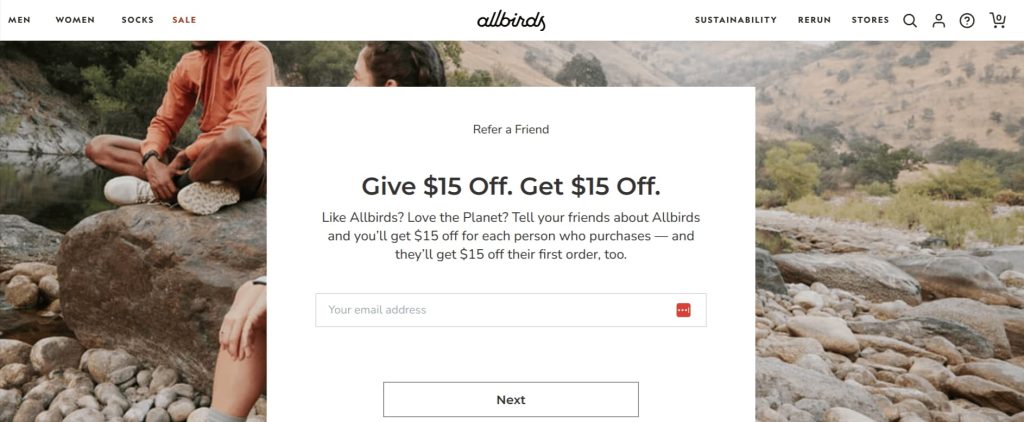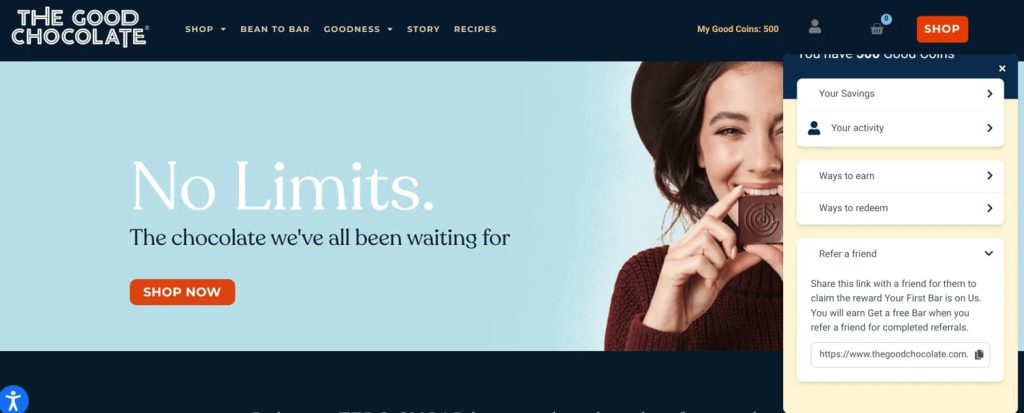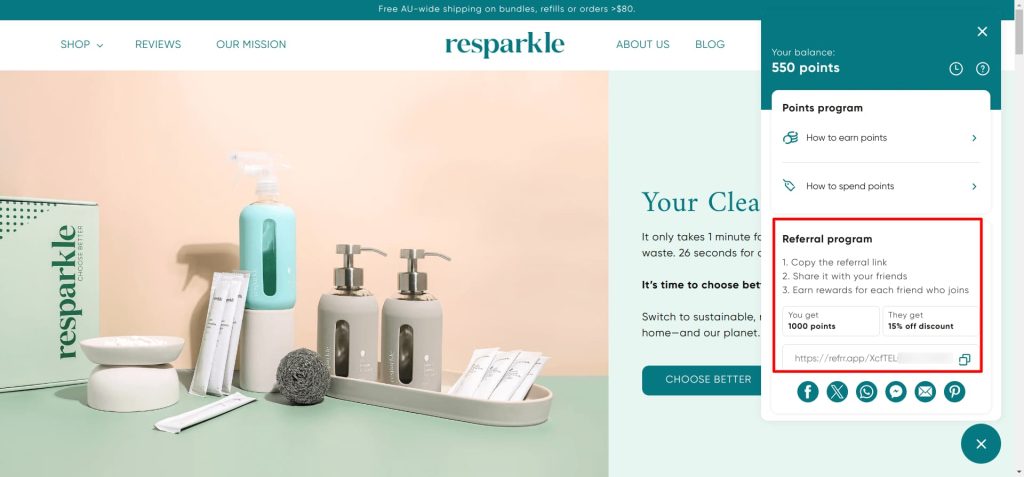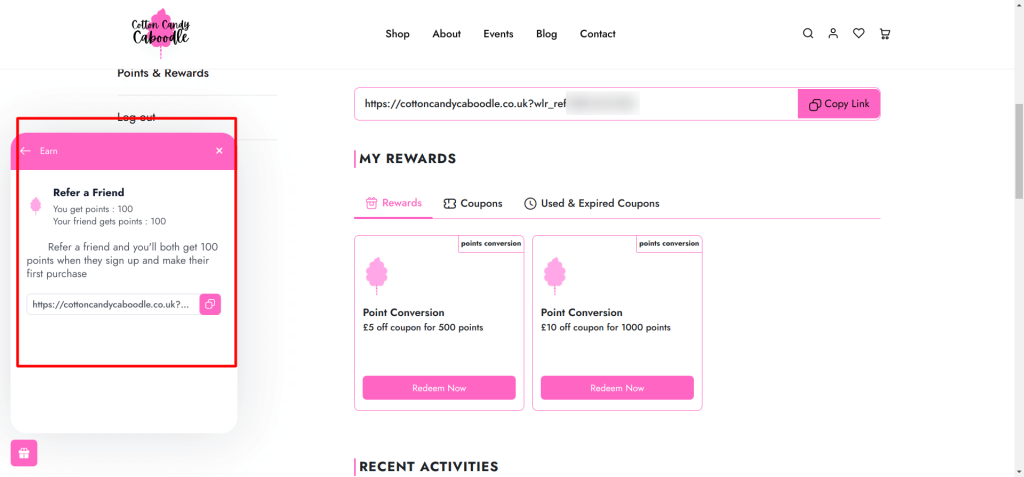Figuring out how to create a referral program from the ground up is daunting, if you want it to be live very quickly and easily.
However, it’s definitely worth the initial effort because referral marketing generates 3-5 times higher conversion rates compared to other marketing channels.
Notably, with a customer 4 times more likely to buy when referred by a friend, referral programs have undoubtedly proven to be one of the most inexpensive marketing techniques, yielding an average ROI of 500%.
So, how do you build an effective refer a friend program? This blog is going to walk you through 8 easy steps to create a customer referral program along with examples of those who got it right.
Create referral programs with WPLoyalty’s customizable referral campaign to acquire and retain loyal customers.
Why Do You Need to Create a Referral Program?
- Higher trust and conversion rates: Referred customers trust recommendations from friends and family more than ads. This trust translates into higher conversion rates, meaning they’re more likely to buy.
- Lower customer acquisition costs: Acquiring new customers through paid ads or SEO is expensive. With a referral program, customers are brought in at a fraction of the cost since your existing customers act as ambassadors.
- Reduces dependence on paid channels: As your store grows, you’re likely spending more on Facebook or Google ads, and those costs keep rising. Refer a friend program creates a channel where your growth isn’t dependent on how much you spend on ads every month.
- Scalable growth without extra marketing spend: Instead of constantly increasing your ad budget, a referral program allows for organic growth. As more customers join, they bring in new customers, creating a cycle of continuous, scalable growth.
- Repeat business from both ends: The customer who refers gets an incentive. The referred customer also has a reason to come back, whether through rewards, discounts, or loyalty-building. So you’re increasing the lifetime value of both the referrer and the referred.
Manual vs. Automated Referral Programs
Creating a referral program can be done in two types: manually and using automated plugins or software.
The first type of setting up and managing a referral program manually is very difficult, especially as your store grows. It’s time-consuming and prone to errors.
On the other hand, creating referral programs with third-party plugins or software and automating the process is much more efficient, saving time on tracking, generating codes, and issuing rewards.
If you’re concerned about third-party tools, you could hire a developer to build an in-house referral system customized to your needs, automating most of the manual tasks.
Limitations of Manual Referral Programs and How Automation Can Solve Them ?
- Customer frustration with delays: Customers want instant rewards when they refer someone. With manual systems, delays are inevitable as you track, verify, and distribute rewards manually.
But with referral plugins reward distribution is fully automated and quick based on your set up, leading to higher customer engagement. - Referral abuse and fraud: Some customers might create fake accounts or refer themselves to game the system. Manually catching these instances is nearly impossible at scale.
A referral software uses algorithms to detect and block fraud automatically. - Manual tracking breaks down with multiple referral sources: If you’re running a referral program across different platforms (social media, emails, etc.), tracking which source brought in a sale becomes a logistical nightmare.
Plugins centralize tracking, ensuring that you attribute the right sales to the right customers without getting buried in spreadsheets. - Complex reward structures: If you offer different tiered reward systems or have specific criteria (e.g., referrals who make their first purchase), managing these complexities by hand is a huge burden.
A referral plugin handles these nuanced reward conditions automatically. - Real-time customer engagement: Without a plugin, you can’t notify customers about their referral progress in real time. This disconnect decreases program effectiveness, as customers are more likely to forget about their referrals if they’re not updated.
Referral software keeps them engaged with real-time updates and reminders, boosting participation. - Lost opportunity for data insights: Manually, you can’t easily see which referrals convert the most, where you’re losing potential customers, or how effective your program is.
Plugins give you these analytics, helping you make informed decisions to fine-tune your referral program for better results.
Now, you know how setting up a referral system using a referral software eases your work. Next, let us show you how to create an effective referral program in 8 easy steps.
How to Create a Referral Program in 8 steps
The eight steps to create a customer referral program:
- Choose a Referral Program Platform
- Define Your Reward Structure
- Prepare Your Campaign Materials
- Launch Communication Strategy
- Set Up Referral Tracking and Analytics
- Implement Fraud Prevention Measures
- Test and Optimize Your Program
- Launch and Scale
1. Choose a Referral Program Platform
The first step to creating a referral program starts from choosing the right referral program software.
Maybe, while starting you could feel that you can manage referral activities from spreadsheets and manual tracking if your customer base is small.
However, you need a reliable referral marketing platform to track referrals accurately, distribute rewards accordingly, and scale your program effectively.
A dedicated referral software helps you:
- Create customizable referral campaigns
- Track referrals automatically
- Manage referral reward distribution
- Monitor referral program performance
- Automate email communications
WPLoyalty is a great example of this. By signing up, you get access to customizable referral campaigns, multiple referral reward types, automated reward tracking, unique referral links for customers, and a detailed dashboard to measure your referral program’s success.
But don’t take our word for it. Try it yourself.
.singleButton a{ border: 0px !important; }Estimated success impact: 40-50% of program effectiveness
2. Define Your Reward Structure
Having chosen your referral platform, you need to set up an attractive reward structure for your program.
But before you do that, you need to carefully consider what would motivate both your existing customers to refer and new customers to act on those referrals.
Naturally, people won’t recommend your product or service without a compelling reason. So, creating a basic “Refer a friend!” message without clear benefits will likely result in low participation rates.
One of the best ways to encourage referrals is to create a double-sided reward structure that benefits both parties.
Here are popular referral reward options that work well:
For Referrers (Existing Customers):
- Loyalty points
- Percentage discounts
- Fixed discounts
- Store credit
- Free months of service
- Exclusive access to new features
- Priority customer support
- VIP status upgrades
- Product upgrades
For Referred Friends (New Customers):
- Loyalty points
- First-time purchase discount
- Extended free trial period
- Bonus features
- Free products
- Free shipping
- Welcome bonus credits
- Complimentary add-ons
- Special onboarding package
Generally, you’ll find that the most successful refer a friend programs offer immediate value to both parties.
Pro Tip: Consider these factors when choosing your incentives:
- Your product price point and margins
- Customer lifetime value
- Industry standards
- Target audience preferences
- Ease of reward fulfillment
- Program sustainability
Estimated impact on program success: 30-40% depending on reward attractiveness.
3. Prepare Your Campaign Materials
After defining your incentive structure, you need to prepare the essential materials that will communicate and promote your referral program.
Here are the essential materials you need to create:
A. Referral Landing Page
Your dedicated referral program page should include:
- Clear program explanation
- Step-by-step participation guide
- Reward details for both parties
- Terms and conditions
- FAQ section
- Sign-up/login options

As you can see in All bird’s example, the refer-a-friend landing page is clean, visually appealing, and immediately communicates the value proposition without overwhelming visitors.
B. Email Templates
Create templates for:
- Program invitation emails
- Referral link sharing
- Reward confirmation
- Welcome messages for referred friends
- Reminder emails
- Success celebration emails
C. Social Sharing Assets
Develop:
- Pre-written social media messages
- Shareable images
- Custom referral links
- Social media cards
- Mobile-friendly sharing buttons
Estimated impact on program success: 20-30% depending on material quality and clarity.
4. Launch Communication Strategy
It’s natural that very few customers will actively search for your refer a friend loyalty program on their own. Therefore, you need to strategically communicate your program through multiple channels and touchpoints throughout the customer journey.
You need a well-defined communication workflow to successfully promote your referral program. Build a communication plan that maps out each step of the process, from the initial program announcement to ongoing engagement messages, up to reward celebration communications.
If your customer engagement strategy includes multiple touchpoints, here’s how to leverage them:
Strategic Touchpoints for Program Communication:
A. Initial Launch Communications
- Company-wide email announcement
- In-app notifications
- Website banner or popup
- Social media announcements
- Blog post announcement
B. Ongoing Customer Touchpoints
- Post-purchase emails
- Order confirmation pages
- Customer support interactions
- Account dashboard notifications
- Receipt/invoice mentions
For example, suppose you notice a customer has just had a positive experience with your product or service.
In that case, it’s the perfect moment to introduce your referral program with a message like “Loving your experience? Share it with friends and both get $30 off your next purchase!”
Estimated impact on program success: 15-25% depending on communication effectiveness
5. Set Up Referral Tracking and Analytics
When building a referral loyalty program, it’s crucial to track performance beyond just counting referrals. In this case, by setting up comprehensive analytics that monitor every aspect of your program, from share rates to conversion values.
Let’s say you want to understand which channels are performing best, which rewards are most effective, or which customers are your top referrers.
It’s far better to have dedicated tracking systems in place than to rely on basic metrics and risk missing valuable insights.
Essential Metrics to Track:
A. Share Rate
- Number of shares per customer
- Share method preferences
- Timing of shares
B. Conversion Rate
- Referral link clicks
- Sign-up completion rate
- Purchase conversion rate
C. Revenue Impact
- Revenue from referred customers
- Average order value from referrals
- Customer lifetime value (CLV) of referred users
D. Program Efficiency
- Cost per referred customer
- Reward distribution rate
- ROI per referral
Estimated impact on program success: 25-35% depending on proper tracking.
6. Implement Fraud Prevention Measures
A referral program without proper fraud prevention is vulnerable to abuse and false claims.
For example, you might find users creating multiple accounts to refer to themselves or submitting fake referrals to collect rewards. To maintain program integrity and protect your budget, implementing robust fraud prevention measures is crucial.
This step is essential to start with because it protects your investment and ensures rewards go to genuine referrals. Here’s how to protect your program:
Common Types of Referral Fraud:
A. Self-Referrals
- Creating multiple accounts
- Using different email addresses
- Using family members’ details
B. Fake Referrals
- Invalid contact information
- Temporary email addresses
- Non-existent users
C. Reward Abuse
- Multiple claims for same referral
- Manipulation of tracking systems
- Exploitation of program loopholes
Estimated impact on program success: 15-25% in protected revenue
7. Test and Optimize Your Program
Before rolling out your referral program to your entire customer base, it’s crucial to test it with a smaller group first.
Reward a few loyal customers who would be perfect candidates for your beta testing phase. Reach out to these customers and invite them to be part of your program’s initial launch.
Key Testing Areas:
A. Technical Elements
- Referral link generation
- Reward distribution
- Email notifications
- Tracking accuracy
- Mobile responsiveness
B. User Experience
- Sign-up process
- Share mechanisms
- Reward claims
- Program understanding
- Communication clarity
C. Program Structure
- Reward appeal
- Terms clarity
- Sharing methods
- Messaging effectiveness
Real Example Implementation Timeline:
- Week 1-2: Internal testing with employees
- Week 3-4: Small group of VIP customers (50-100)
- Week 5-6: Expa
- nded beta group (500-1000)
- Week 7-8: Analysis and optimization
- Week 9: Full program launch
Estimated impact on program success: 30-40% improvement in program performance
Remember: The insights gained during this testing phase are invaluable for optimizing your program before the full launch. Take time to analyze the data and make necessary adjustments.
Launch a fully customized referral program with WPLoyalty and reward your customers with points, discounts, freebies, and more.
8. Launch and Scale
You can start with a soft launch to your most engaged customers – those who frequently purchase, actively engage with your brand, or have previously recommended your products/services.
Additionally, train your customer service team thoroughly. They need to understand every aspect of the program and be ready to answer questions.
Finally, when you’re ready for the full launch, create a promotional calendar that includes customized email announcements, social media posts, website updates, and in-product notifications.
Estimated impact on program success: 15-20%
Examples of Referral Programs Built Using WPLoyalty
1. The Good Chocolate’s Referral Program (eCommerce)

Referral Structure:
- Offer: “Your First Bar is on Us”
- Referral Reward: Get a free bar for successful referrals
- Sharing Method: Unique referral link provided
- Double-Sided Benefit: Both referrer and referred friend receive rewards
Why Does It Work Well?
This referral program example succeeds through its clear value proposition of a free premium chocolate bar for both parties, simple one-click sharing process, and seamless integration with their loyalty program.
2. Resparkle’s Referral Program (eCommerce)

Referral Program Structure
- Referrer Gets: 1000 points
- Friend Gets: 15% off discount
- Sharing Process: Three simple steps
- Copy the referral link
- Share it with friends
- Earn rewards for each friend who joins
- Sharing Options: Multiple channels (Facebook, Twitter, WhatsApp, Pinterest, Email)
Why Does It Work Well?
Their referral program succeeds by combining a reward point system, while offering multiple sharing options.
3. Cotton Candy Caboodle’s (eCommerce)

Referral Program Structure
- Referrer Gets: 100 points
- Friend Gets: 100 points
- Qualification: Points awarded after friend’s first purchase
- Sharing Method: Easy copy-paste referral link
Why Does It Work Well?
The program’s equal point distribution makes it appealing and transparent. The simple structure and immediate reward visibility encourages participation.
Get started with WPLoyalty’s prebuilt referral campaign with multiple reward type options and increase customer loyalty effortlessly
Final Words
Creating a customer referral program cannot happen overnight. However, by following the eight steps and learning from real-world examples mentioned above, you’re setting yourself up for acquiring and retaining more loyal customers.
Some strategies will perform better than others for your specific business. But what’s crucial is to implement these elements systematically and continuously optimize based on your results.
Need a powerful tool to create and manage your referral program? WPLoyalty offers all the features you need to create, track, and optimize your referral loyalty program effectively.
Frequently Asked Questions
1. Install and activate WPLoyalty
2. Choose your rewards (points, discounts, freebies, free shipping)
3. Set up double-sided incentives
4. Create clear program rules
5. Design sharing methods
6. Implement fraud prevention
1. Sign up for the program
2. Get your unique referral link
3. Share with friends via email/social
4. Track your referrals
5. Claim rewards after friend’s purchase
1. Make rewards attractive
2. Keep rules simple
3. Automate tracking
4. Promote regularly
5. Test and optimize
6. Celebrate successful referrals
The average referral rate across industries is 2.3%, with top-performing programs reaching 5-15%. B2B programs typically see 3-5% while B2C programs average 2-3%.
1. Identify suitable friends
2. Share your referral link
3. Follow up gently
4. Help friends sign up
5. Wait for purchase completion
6. Receive your reward
